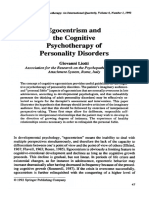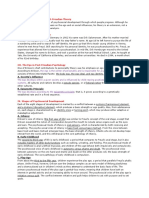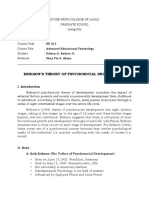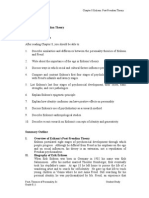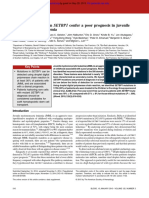0 ratings0% found this document useful (0 votes)
171 viewsAdolescent Egocentrism
Adolescent Egocentrism
Uploaded by
William HallAdolescent Egocentrism exams the essences of the concept for an insert of the subject matter into a larger paper, thus this exists as a short-subject paper.
Copyright:
© All Rights Reserved
Available Formats
Download as DOCX, PDF, TXT or read online from Scribd
Adolescent Egocentrism
Adolescent Egocentrism
Uploaded by
William Hall0 ratings0% found this document useful (0 votes)
171 views4 pagesAdolescent Egocentrism exams the essences of the concept for an insert of the subject matter into a larger paper, thus this exists as a short-subject paper.
Copyright
© © All Rights Reserved
Available Formats
DOCX, PDF, TXT or read online from Scribd
Share this document
Did you find this document useful?
Is this content inappropriate?
Adolescent Egocentrism exams the essences of the concept for an insert of the subject matter into a larger paper, thus this exists as a short-subject paper.
Copyright:
© All Rights Reserved
Available Formats
Download as DOCX, PDF, TXT or read online from Scribd
Download as docx, pdf, or txt
0 ratings0% found this document useful (0 votes)
171 views4 pagesAdolescent Egocentrism
Adolescent Egocentrism
Uploaded by
William HallAdolescent Egocentrism exams the essences of the concept for an insert of the subject matter into a larger paper, thus this exists as a short-subject paper.
Copyright:
© All Rights Reserved
Available Formats
Download as DOCX, PDF, TXT or read online from Scribd
Download as docx, pdf, or txt
You are on page 1of 4
1
Running head: ADOLESCENT EGOCENTRISM
Adolescent Egocentrism
William Hall
August 8, 2012
2
ADOLESCENT EGOCENTRISM
Adolescent Egocentrism
Egocentrism exist as one of the most deeply embedded absence of preoperational view that
appears around the eleventh year of adolescence, nonetheless diminishes around the sixteenth
year. Adolescents often apply recently acquired skill sets on themselves; one course of action
which provides the adolescences loses of their detachment. Throughout their teenage years,
adolescence finds many of their thoughts centering on themselves, their belief postulates that
everyone watches them. The adolescences worries now focus on how others perceive and
observe them and try to assort thru their own conflicting feelings about parents, close friends and
school; considering things more extraordinary, but not always realistically. Additionally,
adolescences not only focus their consideration upon themselves, they also picture what others
think about them (Berk, 2008).
David Elkind (1967) stated that:
While the adolescent is often self-critical, he is frequently self-admiring too. At such times,
the audience takes on the same affective coloration. A good deal of adolescence boorishness,
loudness, and faddish dress is probably provoked, partly in any case, by a failure to
differentiate between what the young person believes to be attractive and what others admire.
(Elkind, 1967, p 1030)
Adolescent egocentrism supports the fallacy of why teens often think they are the focus of
everyones attention, however; this type of egocentrism in adolescent often leads to incorrect
conclusion. The invincibility adolescence fable, one which posits that young individuals have a
belief in which they will by no means succumb to victimization as do others, to any perilous
3
ADOLESCENT EGOCENTRISM
behaviors. A second false conclusion which results from egocentrism in adolescences exists as
the personal fable that posits adolescences imagine their individual lives as quite exceptional.
Their perception of self exists often one in which they in comparison to others exists uniquely
different, distinguishable by experiences of uncommon uniqueness, values, and perspective.
Nevertheless another false conclusion which stems from egocentrism exists in the imaginary
audience; one that arises in adolescences commencing from the assumption in which other
people seem as extremely absorbed with them, as are they in themselves. Numerous
adolescences often seem to hold the belief that they exist on center stage, and consequently, they
continual to visualize how others respond to their behavior and appearance. Granting
egocentrism at beginning of adolescence remains typically evident; establish intuition in the
middle, as well logic in the end. Nevertheless cognition in any of the above aforementioned
forms could appear at any stage of adolescences (Elkind, 1967).
4
ADOLESCENT EGOCENTRISM
Reference
Berk, L. E. (2008). Exploring Lifespan Development (2nd ed.). Boston, MA: Pearson Education,
Inc., Allyn & Bacon.
Elkind, David (1967). Egocentrism in Adolescence. Child Development, 38(4), 1025-1034
Retrieved from http://cmapspublic2.ihmc.us/rid=1KLDGKY40-1B763LJ1MPK/Egocentrism
%20in%20Adolscence.pdf
You might also like
- Appleyard J A The Reader As ThinkerDocument18 pagesAppleyard J A The Reader As ThinkerIris CeylanNo ratings yet
- 9 - Erikson - Post-Freudian TheoryDocument3 pages9 - Erikson - Post-Freudian Theorystephanie100% (1)
- Erikson - Post-Freudian TheoryDocument3 pagesErikson - Post-Freudian Theoryjames bulawinNo ratings yet
- Narcissism KohutDocument16 pagesNarcissism KohutMaurent Alan ErlindaNo ratings yet
- Erik EriksonDocument3 pagesErik EriksonTina NavarroNo ratings yet
- Clinical Implications of Adolescent IntrospectionDocument8 pagesClinical Implications of Adolescent IntrospectionJoshua RyanNo ratings yet
- UTS Module 3-5Document14 pagesUTS Module 3-5ariadnegaydaNo ratings yet
- 1992 - Liotti - Egocentrismo y Terapia Cognitiva de Los Trastorno de La PersonalidadDocument17 pages1992 - Liotti - Egocentrismo y Terapia Cognitiva de Los Trastorno de La PersonalidadVicente Fasce OlmosNo ratings yet
- Erikson's Psycho-Social Theory of DevelopmentDocument52 pagesErikson's Psycho-Social Theory of DevelopmentJohanna Rivas RealonNo ratings yet
- I. Overview of Erikson's Post-Freudian TheoryDocument3 pagesI. Overview of Erikson's Post-Freudian TheorynitinandsubahNo ratings yet
- G-Psyc101 Understanding The SelfDocument4 pagesG-Psyc101 Understanding The SelfRhea Rocha AlfonsoNo ratings yet
- 1.2 Sociological PerspectiveDocument12 pages1.2 Sociological PerspectiveLuna RhNo ratings yet
- ErikDocument16 pagesEriksheynakashiNo ratings yet
- Lesson 7 Life Span Theory Erik EriksonDocument5 pagesLesson 7 Life Span Theory Erik EriksonJulianna NicoleNo ratings yet
- Note Highligths The Important Only F Not Close Parenthises Thats Explain (Ucsp)Document13 pagesNote Highligths The Important Only F Not Close Parenthises Thats Explain (Ucsp)Coleen Jhoy SieteNo ratings yet
- AdolescenceDocument48 pagesAdolescencekate kimeridzeNo ratings yet
- Literature Review: ADLN Perpustakaan Universitas AirlanggaDocument13 pagesLiterature Review: ADLN Perpustakaan Universitas Airlanggayowan wandikboNo ratings yet
- Introduction To Psychology Chapter 3Document8 pagesIntroduction To Psychology Chapter 3cheeyin666No ratings yet
- The Psychosocial StagesDocument2 pagesThe Psychosocial StagesWinston PlarizaNo ratings yet
- Emotional, Identity, and Social Development in AdolescenceDocument38 pagesEmotional, Identity, and Social Development in AdolescencefefeNo ratings yet
- Chapter I: The Self From Various Perspective: B. SociologyDocument13 pagesChapter I: The Self From Various Perspective: B. SociologyCherry Mae CabuangNo ratings yet
- Erickson & MarciaDocument9 pagesErickson & Marciapramod harlalkaNo ratings yet
- 2.2.3 Erik Eiksons Psychosocial DevelopmentDocument6 pages2.2.3 Erik Eiksons Psychosocial DevelopmentEmil BarengNo ratings yet
- Adolescence: Physical and Sexual Maturation The Growth SpurtDocument2 pagesAdolescence: Physical and Sexual Maturation The Growth SpurtZie BeaNo ratings yet
- Erikson's Theory of Personality by Saher Hiba Khan (20185826) (Dept. of English)Document3 pagesErikson's Theory of Personality by Saher Hiba Khan (20185826) (Dept. of English)Saher Hiba KhanNo ratings yet
- A Development Concept of Adolescence - The Case of Adolescents in The PH (Ogena, N.D.)Document19 pagesA Development Concept of Adolescence - The Case of Adolescents in The PH (Ogena, N.D.)Marianne SasingNo ratings yet
- Lesson 2Document23 pagesLesson 2Apple joy PepitoNo ratings yet
- Erikson Stages V-ViiiDocument10 pagesErikson Stages V-ViiimanuelkarimNo ratings yet
- Social Work Practice With AdolescentsDocument44 pagesSocial Work Practice With AdolescentsRoselyn Nebreja-RemoquilloNo ratings yet
- ADOLESCENT-20241203-WA0003Document18 pagesADOLESCENT-20241203-WA0003favour.b247No ratings yet
- Acquaring A Sense of Intimacy Versus IsolationDocument6 pagesAcquaring A Sense of Intimacy Versus IsolationMegaNo ratings yet
- 5 Levels of Self-AwarenessDocument15 pages5 Levels of Self-Awarenesselgorilagrande100% (1)
- Feist8e SG Ch08Document8 pagesFeist8e SG Ch08yvonneymNo ratings yet
- Chapters 6 7 EDFLCTDocument27 pagesChapters 6 7 EDFLCTjnpolines.chmsuNo ratings yet
- Capstone AssignmentDocument7 pagesCapstone Assignmentapi-512270694No ratings yet
- The Transition From Childhood To Adolescence Can Evoke A Myriad of EmotionsDocument2 pagesThe Transition From Childhood To Adolescence Can Evoke A Myriad of Emotionsshaileshkmr1976No ratings yet
- Ego Identity Test (Basic Concepts)Document15 pagesEgo Identity Test (Basic Concepts)Nawazish AnsariNo ratings yet
- Annotated Source List IrDocument20 pagesAnnotated Source List Irapi-753615361No ratings yet
- Symbolic Consumption by Teenagers: A Discussion Through The Optics of Appearance and IdentityDocument7 pagesSymbolic Consumption by Teenagers: A Discussion Through The Optics of Appearance and IdentityNilanjana SinhaNo ratings yet
- Sel Awareness Rough DraftDocument15 pagesSel Awareness Rough Draftapi-351451965No ratings yet
- Chapter 8 Erikson: Post-Freudian TheoryDocument12 pagesChapter 8 Erikson: Post-Freudian TheoryDaniel Buan100% (1)
- Intimacy Versus Isolation and GenerativityDocument7 pagesIntimacy Versus Isolation and Generativityapi-490751692No ratings yet
- Notes - Week 13 - Adolescent-Socioemotional DevelopmentDocument29 pagesNotes - Week 13 - Adolescent-Socioemotional DevelopmentSyuhadaNo ratings yet
- Unit 3 Identity Self Concept, Self Esteem, Peer Group RelationshipDocument11 pagesUnit 3 Identity Self Concept, Self Esteem, Peer Group RelationshipRajeshNo ratings yet
- Schafer - 1973 - Concepts of Self and IdentityDocument19 pagesSchafer - 1973 - Concepts of Self and IdentityHanni JuhaszNo ratings yet
- Developmental PsychologyDocument4 pagesDevelopmental PsychologyYuri Ferrer KimNo ratings yet
- Adolescent Is A Period of Storm and Stres1Document4 pagesAdolescent Is A Period of Storm and Stres1Sunday Damilola100% (10)
- SociobypearlDocument30 pagesSociobypearlgray ronan100% (3)
- Module7 130118170434 Phpapp02 PDFDocument41 pagesModule7 130118170434 Phpapp02 PDFnepen theNo ratings yet
- BPCG-172 E_Block-2Document64 pagesBPCG-172 E_Block-2Ilyas ChowdhuryNo ratings yet
- Arlene F. Harder, MA, MFTDocument2 pagesArlene F. Harder, MA, MFTRhoda Vasquez-PallarcaNo ratings yet
- Teen DevelopmentDocument1 pageTeen DevelopmentAanya MakhijaNo ratings yet
- Psychosocial TheoryDocument30 pagesPsychosocial TheoryChing MaravillaNo ratings yet
- Self Awareness 1 Running Head: SELF AWARENESSDocument15 pagesSelf Awareness 1 Running Head: SELF AWARENESSapi-351451965No ratings yet
- Midterm (HBV)Document16 pagesMidterm (HBV)Angelito Garcia Jr.No ratings yet
- Report GRP3 Semi FinishedDocument28 pagesReport GRP3 Semi FinishedzDenzel LariozaNo ratings yet
- AdolDocument71 pagesAdolrakshanda.2900aNo ratings yet
- Erikson's Stages of Psychosocial Development - Theory & Examples - Video & Lesson TranscriptDocument3 pagesErikson's Stages of Psychosocial Development - Theory & Examples - Video & Lesson TranscriptAndrei PostolacheNo ratings yet
- NArcissistic Personality Disorder CombinedDocument4 pagesNArcissistic Personality Disorder Combinedarra resuelloNo ratings yet
- An exploratory study of the effect of age and gender on innocenceFrom EverandAn exploratory study of the effect of age and gender on innocenceNo ratings yet
- Appendix 4: Week 5 Pre-ReadingDocument4 pagesAppendix 4: Week 5 Pre-ReadinggamzeNo ratings yet
- RefugeeArtsConsultation WondeseebnnDocument90 pagesRefugeeArtsConsultation WondeseebnnwondesenNo ratings yet
- Software Quality Management TutorialDocument14 pagesSoftware Quality Management TutorialAnusha ReddyNo ratings yet
- Statistics ReviewerDocument3 pagesStatistics ReviewerRenatoCosmeGalvanJunior100% (1)
- Middle Test English Lesson Keperawatan Semester 4Document14 pagesMiddle Test English Lesson Keperawatan Semester 4Syafara Al QomariyahNo ratings yet
- CNG Market AnalysisDocument57 pagesCNG Market AnalysisDeepak VermaNo ratings yet
- Context Development: MOZOL, Marr Miguel M. PALEN, James Albert L. SINDAY, Camille CDocument14 pagesContext Development: MOZOL, Marr Miguel M. PALEN, James Albert L. SINDAY, Camille CRosemarie R. ReyesNo ratings yet
- Myeloid NeoplasiaDocument10 pagesMyeloid NeoplasiaivssonNo ratings yet
- Cma Fou SogaDocument15 pagesCma Fou SogaPrashant ShahaneNo ratings yet
- Criminal Law 2 Study Guide April 30Document13 pagesCriminal Law 2 Study Guide April 30poppy2890No ratings yet
- Peace Education Group 1Document4 pagesPeace Education Group 1marissalibosana9No ratings yet
- Pessary IdeasDocument8 pagesPessary IdeasPngNo ratings yet
- Kuesioner Irrational Beliefs 2Document18 pagesKuesioner Irrational Beliefs 2Naili MurodahNo ratings yet
- Christian Apologetics in Philippine Setting and Young Peopl's ViewDocument10 pagesChristian Apologetics in Philippine Setting and Young Peopl's ViewRoel AgustinNo ratings yet
- Ramanujan's Analysis - Otras LiteraturasDocument1 pageRamanujan's Analysis - Otras LiteraturasMar MartinezNo ratings yet
- Aleksandar Backo OsvrtDocument109 pagesAleksandar Backo OsvrtNenad RawNo ratings yet
- The - Business - PI - SB 12Document1 pageThe - Business - PI - SB 12Agrafena GrekNo ratings yet
- Irreantum, Vol. 4, No. 2, Summer 2002Document108 pagesIrreantum, Vol. 4, No. 2, Summer 2002Andrew HallNo ratings yet
- By Katharine Hansen: Behavioral Interviewing Strategies For Job-SeekersDocument3 pagesBy Katharine Hansen: Behavioral Interviewing Strategies For Job-SeekersManuel Hugo Luarte JaraNo ratings yet
- λ-Calculus: a Turing machine."-Alonzo ChurchDocument13 pagesλ-Calculus: a Turing machine."-Alonzo ChurchBrianNo ratings yet
- Curriculum Eae 4cDocument10 pagesCurriculum Eae 4capi-238523254No ratings yet
- Employment News 27 To 3 JulyDocument34 pagesEmployment News 27 To 3 Julyعائشہ کرنیکاNo ratings yet
- A Fistful of DiceDocument44 pagesA Fistful of DiceSam Beuglass100% (1)
- Unit 1 Hello There!: PAG E Lesson Vocabulary Grammar Listening Track: UNIT 1Document10 pagesUnit 1 Hello There!: PAG E Lesson Vocabulary Grammar Listening Track: UNIT 1Analia SanlongNo ratings yet
- JCS: Female Gladiators of The Ancient Roman World: MurrayDocument1 pageJCS: Female Gladiators of The Ancient Roman World: MurrayDali Khobakhia100% (1)
- Principes of Personal Christian WitnessDocument205 pagesPrincipes of Personal Christian WitnessForever FaithfulNo ratings yet
- Classic ScrapesDocument220 pagesClassic Scrapesbetalpha100% (3)
- State of Bombay V RMDCDocument35 pagesState of Bombay V RMDCSudhir Kochhar Fema AuthorNo ratings yet
- Activity Sheets in English Grade 6: Balatoc Elementary SchoolDocument6 pagesActivity Sheets in English Grade 6: Balatoc Elementary SchoolWennie CawisNo ratings yet
- ICW Position Statement 2015 CRIMINALIZATION OF WOMEN LIVING WITH HIV: NON-DISCLOSURE, EXPOSURE, AND TRANSMISSIONDocument2 pagesICW Position Statement 2015 CRIMINALIZATION OF WOMEN LIVING WITH HIV: NON-DISCLOSURE, EXPOSURE, AND TRANSMISSIONHIV Justice NetworkNo ratings yet







